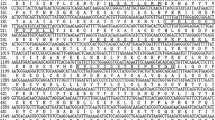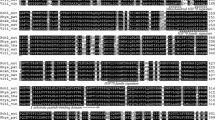Abstract
Molecular chaperones (Hsps) have been shown to facilitate protein folding or assembly under various developmental and adverse environmental conditions. The aim of this study was to unravel a possible role of heat-shock proteins in conferring abiotic stress tolerance to plants. We isolated a cDNA encoding a cytoplasmic Hsp70 (PgHsc70) from Pennisetum glaucum by screening heat-stress cDNA library. PgHsc70 cDNA encoding 649 amino acids represents all conserved signature motifs characteristic of Hsp70s. The predicted molecular model of PgHsc70 protein suggests that the N-terminus ATP-binding region is evolutionarily conserved, in comparison to C-terminus peptide-binding domains. A single intron in ATPase domain coding region of PgHsc70 exhibited a high degree of conservation with respect to its position and phasing among other plant Hsp70 genes. Recombinant PgHsc70 protein purified from E. coli possessed in vitro chaperone activity and protected PgHsc70 expressing bacteria from damage caused by heat and salinity stress. Nucleotide sequence analysis of 5′ flanking promoter region of PgHsc70 gene revealed a potential heat-shock element (HSE) and other putative stress-responsive transcription factor binding sites. Positive correlation existed between differentially up-regulated PgHsc70 transcript levels and the duration and intensity of different environmental stresses. Molecular and biochemical analyses revealed that PgHsc70 gene was a member of the Hsp70 family and suggested that its origin was from duplication of a common ancestral gene. Transcript induction data, presence of several putative stress-responsive transcription factor-binding sites in the promoter region of PgHsc70 and the presence of a protective in vitro chaperone activity of this protein against damage caused by heat and salinity, when expressed in E. coli, suggest its probable role in conferring abiotic stress tolerance to this plant.










Similar content being viewed by others

Abbreviations
- ABA:
-
Abscisic acid
- ATP:
-
Adenosine triphosphate
- Hsc70:
-
Heat-shock cognate protein 70
- HSE:
-
Heat-shock element
- RE assay:
-
Restriction enzyme assay
- SA:
-
Salicylic acid
References
Aparicio F, Thomas CL, Lederer C, Niu Y, Wang DW, Maule AJ (2005) Virus induction of heat-shock protein 70 reflects a general response to protein accumulation in the plant cytosol. Plant Physiol 138:529–536
Boorstein WR, Ziegelhoffer T, Craig EA (1994) Molecular evolution of the Hsp70 multigene family. J Mol Evol 38:1–17
Bukau B, Horwich AL (1998) The Hsp70 and Hsp60 chaperone machines. Cell 92:351–366
Chomczynski P, Sacchi N (1987) Single-step method of RNA isolation by acid guanidium thiocyanate–phenol–chloroform extraction. Anal Biochem 162:156–159
Flaherty KM, DeLuca FC, McKay DB (1990) Three-dimensional structure of the ATPase fragment of a 70 K heat-shock cognate protein. Nature 346:623–628
Flaherty KM, DeLuca FC, McKay DB (1994) Three-dimensional structure of ATP-ase fragment of a 70-kD heat-shock cognate protein. Nature 346:623–628
Frydman J (2001) Folding of newly translated proteins in vivo: the role of molecular chaperones. Annu Rev Biochem 70:603–647
Gässler SC, Buchberger A, Laufen T, Mayer MP, Schröder H, Valencia A, Bukau B (1998) Mutations in the DnaK chaperone affecting interaction with the DnaJ co-chaperone. Biochemistry 95:15229–15234
Guy CL, Li QB (1998) The organization and evolution of the spinach stress 70 molecular chaperone gene family. Plant Cell 10:539–556
Hartl FU (1996) Molecular chaperones in cellular protein folding. Nature 381:571–580
He Z, Xie R, Wang Y, Zou H, Zhu J, Yu G (2008) Cloning and characterization of a heat-shock protein 70 gene, MsHsp70–1 in Medicago sativa. Acta Biochim Biophys Sin 40:209–216
Joshi JP (1987a) An inspection of the domain between putative TATA box and translation start site in 79 plant genes. Nucleic Acids Res 15:6643–6653
Joshi JP (1987b) Putative polyadenylation signals in nuclear genes of higher plants: a compilation and analysis. Nucleic Acids Res 15:9627–9640
Karlin S, Brocchieri L (1998) Heat-shock protein 70 family: multiple sequence comparisons, function, and evolution. J Mol Evol 47:565–577
Kiang JG, Tsokos GC (1998) Heat-shock protein 70 kDa: molecular biology, biochemistry and physiology. Pharmacol Ther 80:183–201
Lodhi MA, Ye GN, Weeden NF, Reisch BI (1994) A simple and efficient method for DNA extraction from grapevine cultivars and Vitis species and Ampelopsis. Plant Mol Biol Rep 12:6–13
Mahroof R, Zhu KY, Neven L, Subramanyam B, Bai J (2005) Expression patterns of three heat-shock protein 70 genes among developmental stages of the red flour beetle, Tribolium castaneum (Coleoptera: Tenebrionidae). Comp Biochem Physiol A Mol Integr Physiol 141:247–256
Mishra RN, Reddy PS, Nair S, Markandeya G, Reddy AR, Sopory SK, Reddy MK (2007) Isolation and characterization of expressed sequence tags (ESTs) from subtracted cDNA libraries of Pennisetum glaucum seedlings. Plant Mol Biol 64:713–732
Napolitano EW, Pachter JS, Liem RK (1987) Intracellular distribution of mammalian stress proteins. Effects of cytoskeletal-specific agents. J Biol Chem 262:1493–1504
Nikolaidis N, Nei M (2004) Concerted and nonconcerted evolution of the Hsp70 gene super family in two sibling species of nematodes. Mol Biol Evol 21:498–505
Pfaffl MW, Horgan GW, Dempfle L (2002) Relative expression software tool (REST) for group-wise comparison and statistical analysis of relative expression results in real-time PCR. Nucleic Acids Res 30:e36
Reddy PS, Mahanty S, Kaul T, Nair S, Sopory SK, Reddy MK (2008a) A high-throughput genome walking method and its use for cloning unknown flanking sequences. Anal Biochem 381:248–253
Reddy PS, Nair S, Mallikarjuna G, Kaul T, Markandeya G, Sopory SK, Reddy MK (2008b) A high-throughput, low-cost method for the preparation of “sequencing-ready” phage DNA template. Anal Biochem 376:258–261
Renner T, Waters ER (2007) Comparative genomic analysis of the Hsp70 s from five diverse photosynthetic eukaryotes. Cell Stress Chaperones 12:172–185
Sali A, Blundell TL (1993) Comparative protein modelling by satisfaction of spatial restraints. J Mol Biol 234:779–815
Santacruz H, Vriz S, Angelier N (1997) Molecular characterization of a heat-shock cognate cDNA of zebrafish, hsc70, and developmental expression of the corresponding transcripts. Dev Genet 21:223–233
Santhoshkumar P, Sharma KK (2001) Analysis of alpha-crystallin chaperone function using restriction enzymes and citrate synthase. Mol Vis 7:172–177
Sung DY, Vierling E, Guy CL (2001) Comprehensive expression profile analysis of the Arabidopsis Hsp70 gene family. Plant Physiol 126:789–800
Wang W, Vinocur B, Shoseyov O, Altman A (2004) Role of plant heat-shock proteins and molecular chaperones in the abiotic stress response. Trends Plant Sci 9:244–252
Acknowledgments
This work was supported in part by the Department of Biotechnology (Ministry of Science and Technology, Government of India) in terms of a research grant and from internal grants of ICGEB.
Author information
Authors and Affiliations
Corresponding author
Additional information
Communicated by C. Gebhardt.
PgHsc70 cDNA Acc# GQ254653; PgHsc70 Genomic sequence Acc# GQ979966; PgHsc70 Promoter Acc# EU620496.
Rights and permissions
About this article
Cite this article
Reddy, P.S., Mallikarjuna, G., Kaul, T. et al. Molecular cloning and characterization of gene encoding for cytoplasmic Hsc70 from Pennisetum glaucum may play a protective role against abiotic stresses. Mol Genet Genomics 283, 243–254 (2010). https://doi.org/10.1007/s00438-010-0518-7
Received:
Accepted:
Published:
Issue Date:
DOI: https://doi.org/10.1007/s00438-010-0518-7



